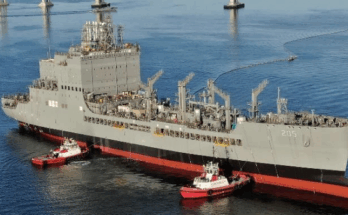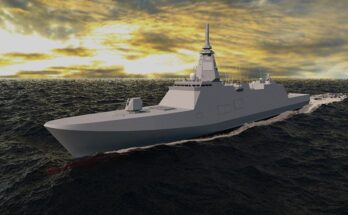A long-planned upgrade for Taiwan’s two Dutch-built Hai Lung-class submarines will soon get underway after the project was given clearance by Netherlands-based RH Marine following a year-long evaluation into the program’s technical feasibility.
The project is part of a sweeping 12-project domestic naval shipbuilding plan estimated at upwards of $15 billion that will run through 2040. Programs within the larger project involve the building of new large-scale naval vessels or modernization of existing capital assets.
One core element of the larger naval renewal effort involves revisiting the Republic of China (RoC) Navy’s limited submarine fleet with an eye on expanding and upgrading this undersea capability.
The first step involves tackling a crucial modernization and service-life extension aimed at keeping the Hai Lung-class submarines operational.
Taiwan President Tsai Ing-wen waves as she boards Hai Lung-class submarine (SS-794) during her visit to a navy base in Kaohsiung, Taiwan. pic.twitter.com/D0QWzgn8cP— Boateng Duka Kofi (@DukaKofi) March 22, 2017
Based on the Royal Netherlands Navy’s Zwaardvis design, the two submarines have now been in RoC Navy service for more than 30 years of their 35-year life spans and require upgrades to their electronic warfare and combat systems (work slated for Taiwan’s Chung Shan Institute of Science and Technology, or CSIST), plus the equipping of long-range heavy torpedoes (Mark 48) supplied by the United States. CSIST will now begin contracting and licensing procedures, followed by combat systems software design and equipment purchasing next year.
The hope is to refit the submarines with help from RH Marine over a three-year period between 2020 and 2022 thereby enabling the subs to remain in service beyond the 2030s.
While the upgrade of the two existing Hai Lung conventional attack submarines (SSKs) forms part of this effort, the more ambitious – and uncertain – plan calls for building an eight-unit class of 1,200-3,000-ton diesel-electric submarines over a 25-year period. This is referred to as the referred to as Indigenous Defense Submarine (IDS) project and is seen as crucial to President Tsai Ing-wen’s ambition to bolster Taiwan’s local defense industry to a level capable of sustaining the Taiwanese military without having to depend on foreign suppliers.
Over the past several decades such suppliers have grown increasingly wary of risking mainland China’s wrath by supplying Taipei with military hardware necessary for the island’s defense. As a result Taiwan’s former military technology edge vis-à-vis the communist People’s Republic of China, its principal strategic threat, has gradually eroded leaving the island state vulnerable on both in quantitative and qualitative levels.
The Hai Lung-class submarines are a case in point: acquired under a 1981 agreement with the Netherlands that called for the sale of six submarines to Taiwan (two built in the Netherlands, four to be built locally), only two were ultimately sold to Taiwan. In the face of furious objections from Beijing and its downgrading of diplomatic ties to the Dutch government, the Netherlands turned down a Taiwanese request for the additional four submarines in 1992.
Dan Darling is Forecast International’s director of military and defense markets. In this role, Dan oversees a team of analysts tasked with covering everything from budgeting to weapons systems to defense electronics and military aerospace. Additionally, for over 17 years Dan has, at various times, authored the International Military Markets reports for Europe, Eurasia, the Middle East and the Asia-Pacific region.
Dan's work has been cited in Defense News, Real Clear Defense, Asian Military Review, Al Jazeera, and Financial Express, among others, and he has also contributed commentary to The Diplomat, The National Interest and World Politics Review. He has been quoted in Arabian Business, the Financial Times, Flight International, The New York Times, Bloomberg and National Defense Magazine.
In addition, Dan has made guest appearances on the online radio show Midrats and on The Media Line, as well as The Red Line Podcast, plus media appearances on France 24 and World Is One News (WION).




